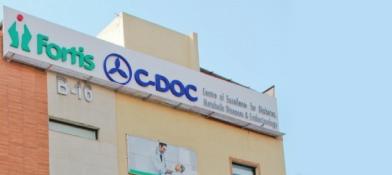Knee osteotomy
Overview
Osteoarthritis (OA) is a joint disease affecting the knee or the hip. When a joint loses cartilage, the bone tries to repair it by growing, but sometimes it can be abnormal, leading to deformed, painful, and unstable joints. Apart from the loss of typical structure, this abnormal structural change further affects the ability to use the joints for normal function. There are two main types of surgery used to treat such patients with OA of the knee: knee replacement and osteotomy.
Osteotomy is a surgical procedure of cutting, reshaping, and realigning the knees. The abnormal weights carried on a joint will be shifted from the affected part of the knee to the healthy part. Osteotomy unloads the damaged cartilage of the affected knee, thus decreasing pain, improving function, and delaying knee deterioration. It can also delay the necessity of any further surgeries like partial or total knee replacement surgery.
Indications
Osteotomy involves cutting, reshaping, adding, and realigning the bones. It is done to rectify the alignment of any deformed joints and shift the weight from a damaged joint to normal or healthy areas of the joint, to alter the angle, bowing, or rotation of the bones or joints, repair any damaged joints, change the alignment of unjoined joints, shorten or lengthen the bones, to fix any other bone/joint issues due to any other causes, to treat Osteoarthritis. It can also delay the need for knee or joint replacement surgeries in people of a young age group.
Knee osteotomy is preferred as it preserves the natural tissue surrounding the knee, keeps all the bones and joints intact, and gives a chance to postpone or eliminate the need for knee replacement surgery and a revision knee surgery later. Age (< 60 years), active lifestyle, pain on one side of the knee due to increased activity or long periods of standing, and no pain in the kneecaps are some clinical indications for knee osteotomy.
Types of Knee osteotomy
Knee osteotomy is done to cut, reshape, or realign the kneecap involving the shinbone (tibia) or thigh bone (femur). There are various types of knee osteotomies depending on the part of the knee involved or damaged. The major types include the tibial osteotomy, which corrects the bow-legged alignment. Bow leg-aligned knees put a lot of pressure on the inner side of the knee. High tibial osteotomy is another procedure for knee alignment in individuals with knee arthritis. Fulkerson osteotomy is another type where a small part of the tibial bone is removed to reduce the pressure from the kneecap.
Before Knee Osteotomy procedure
Before undergoing a knee osteotomy procedure, an individual should get a surgical profile done, including blood tests, urine tests, an Electrocardiogram (ECG), and a few imaging studies (Chest x-ray, computed tomography, or Magnetic resonance Imaging). This helps healthcare professionals (HCPs) to understand the functioning of other organs, gives information about general health status, and helps them to identify any factors that may interfere with bone healing, like diabetes or any infections. An Electrocardiogram may be needed to check the electrical activity of the heart, and a chest x-ray may be necessary to check the functioning of the lungs.
Imaging studies of the bones/joints, such as computed tomography (CT) scan or magnetic resonance imaging (MRI), are needed to visualize the bones and joints. These imaging studies also help the HCPs to develop the surgical plan, which needs to determine the exact size, shape, dimensions, and angles of the bone section to be removed. A detailed history of past surgeries and any medications being taken should be provided before the surgery. Certain drugs like blood thinners might have to be stopped before surgeries, and other medicines that an HCP finds necessary might have to be taken.
During Knee Osteotomy
Knee osteotomy is done in a hospital under anesthesia. Anesthesia can be general, which makes the individual sleep, or regional to anesthetize only the surgical area, spinal to anesthetize the body from below the waist, or local to anesthetize only the surgical site. After sterilizing the surgical site with an antibacterial solution, a cut is made on the front of the below kneecap. Using the guide wires, the exact area of the bone is reached to remove the outline of the bone using a particular surgical saw.
The bone edges are brought together by removing the diseased or damaged bone section. The gap is reduced by either adding a bone graft or adapting the bone edges together. The bones are held in place and realigned with pins, screws, staples, plates, or rods. These help the bones to heal. They may be placed either temporarily or permanently.
After Knee Osteotomy
Close monitoring of the patients will be done in the recovery phase until the vitals are stabilized, and then discharged after 1 or 2 days. Necessary medications include painkillers to reduce the post-operative pain and antibiotics to avoid any infections. Crutches or knee braces may be prescribed for a few days. Repeat x-rays may be taken to check for healing. Individuals will also be advised to undergo specific rehabilitation exercises to increase the knee's range of motion or restore strength.
Risks and Complications of knee osteotomy
The risks of knee osteotomy are mainly related to the surgical procedure, which includes infections, blood clots due to injuries to vessels and nerves, and failure of the osteotomy site to heal.
Conclusion:
Knee osteotomy is a valuable surgical option for osteoarthritis patients, as it can realign the knee, shift the burden away from damaged areas, and potentially delay or avoid knee replacement surgery. This procedure preserves the knee's natural anatomy and supports continued physical activity, especially for younger patients or those leading active lifestyles. By addressing alignment and weight distribution issues within the knee joint, osteotomy can significantly improve pain and functional outcomes, enhancing the quality of life for patients.































